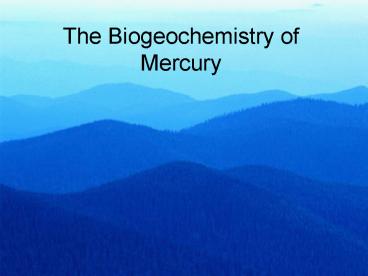The Biogeochemistry of Mercury - PowerPoint PPT Presentation
1 / 59
Title: The Biogeochemistry of Mercury
1
The Biogeochemistry of Mercury
2
Principal forms and transformations of mercury in
the environment
(redrawn from Jitaru and Adams 2004)
3
Terrestrial Hg cycle
4
Terrestrial Hg cycle
(redrawn from Hall 2007)
5
Terrestrial Hg balance
(redrawn from Drigal 2002)
6
The importance of wetlands
(redrawn from Drigal 2002)
7
Separating the new from the old
8
Aquatic Hg cycle
9
(redrawn from Huckabee et al 1994)
10
Bioacumulation and biomagnification
Methyl mercury concentration in a typical
freshwater foodweb
(Redrawn from Jones and Slotton 1996)
11
Mercury dynamics in the atmosphere
12
Natural sources of mercury
13
Anthropogenic sources of mercury
14
Historical deposition
15
(No Transcript)
16
(No Transcript)
17
The geography of Hg contamination
18
(No Transcript)
19
(No Transcript)
20
Who is responsible ?
21
What are the main anthropogenic sources?
22
Where does it all go?
23
Does pollution control work?
24
(No Transcript)
25
(No Transcript)
26
(No Transcript)
27
Mercury in Reservoirs
28
Fludex Experiments short term effects
(redrawn from Hall et al 2005)
29
Long term effects
(redrawn from Bodaly et al 1994)
30
Effects on aquatic biota
(redrawn from Bodaly et al 1994)
31
Effects on human populations
Peacock bass
Human hair
(Weisser and Forsberg, unpublished)
32
Mercury in the Amazon goldminers and peacock
bass
33
(No Transcript)
34
(No Transcript)
35
Finding mercury where it isnt supposed to be
Redrawn from Silva-Forsberg et al. 1999
36
Where did it come from?
37
When did it get there?
Global Anthropogenic sources
Amazon gold mining
38
Where does it really come from?
- Mercury is derived predominantly from the soils
and is natural in origin
(redrqwn from Zeidemann 1998)
39
How does it get in the river?
MERCURY MASS BALANCE
Campina Basin (hydromorphic podsol)
Barro Branco Basin (latossol)
NET EXPORT 10µg/m2
NET EXPORT 20µg/m2
(redrqwn from Pacheco 2007)
40
What happens further downstream?
(redrqwn from Scheideman 2005)
41
What controls bioaccumulation?
- Water chemistry
- pH
- DOC
- Availability of methylation sites
- Wetlands
- Hydromorphic soils?
42
Flooded forest
Dry foreest
Open water/wet savana
Distribution of wetlands in the Negro River Basin
43
Distribution of hydromorphic soils in the Negro
basin
44
BIO-INDICATORS
45
COLLECTION SITES
46
Estimation of wetland area with JERS-1 L-band SAR
imagery
Image supplied by NASDA, Japan
47
Estimation of hydromorphic soil area from digital
soil maps, Hydromorphic soils indicated in
yellow.
Image supplied by NASDA, japan Soil map from
IBGE (1997)
48
- Hgtotal B0 B1(SL) B2(pH) B3(DOC)
B4(HMS) B4(W) - Hgtotal total mercury in fish, ppm
- SL standard length of fish, cm
- pH pH in surface water
- DOC dissolved organic carbon, mg/l
- HMS of hydromorphic soils in upstream
drainage basin and - W of wetlands in upstream drainage basin
49
Cichla spp.
Hoplias sp.
(redrawn from Belger and Forsberg 2006
50
(redrawn from Belger and Forsberg 2006
51
Hoplias sp.
(redrawn from Belger and Forsberg 2006
52
(redrawn from Belger and Forsberg 2006
53
Negro
Flooded forest
Dry forest
Open water/ savana
Maderia
Tapajós
Why do fish and people from the Negro have higher
mercury levels?
54
Consequences for human health?
55
(No Transcript)
56
(No Transcript)
57
(No Transcript)
58
(No Transcript)
59
(No Transcript)

